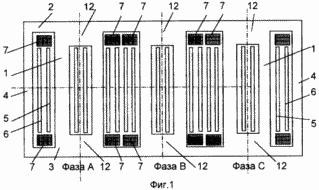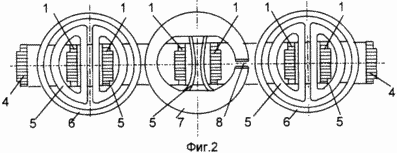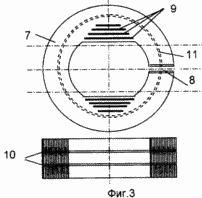| section Home
Production, Amateur Radio amateur Model aircraft, rocket- Useful, entertaining |
Stealth master
Electronics Physics Technologies invention |
space Mystery
Earth Mysteries Secrets of the Ocean Stealth section Map |
|
| Use of material is permitted for reference (for websites - hyperlinks) | |||
Navigation: => |
Home / Products Patents / In the section of the catalog / back / |
|
INVENTION
Russian Federation Patent RU2217829
![]()
ELECTRIC reactor with bias
Name of the inventor: Bryantsev AM (RU); AI Lurie (RU); Biki Mengert Akoshevich (UA); Ukolov Sergey name of the patentee: Bryantsev Alexander
Address for correspondence:
Starting date of the patent: 2001.12.19
The invention relates to electrical engineering and can be used for example in electrical networks to compensate reactive power. Electric reactor comprises a magnetic system with average rods, yokes, two side yokes. Placed in the middle of the winding control rods connected to a regulated DC voltage source. Network winding covering two adjacent web-enabled control winding. Between the ends of the windings and yokes placed shunts ring with a radial slit. Each of them is wound from a strip of electrical steel and with inserts of electrical steel sheets having a width equal to the width of the tape. The inserts are placed between its layers. Ring shunts made on a form corresponding to the shape of the ends of the winding section protruding beyond outline of the magnetic system. The ratio of the minimum cross section of each steel ring shunt to the cross section of each steel rod average is in the range from 1/8 to 1/4. The yokes of the magnetic system are made with areas of different cross-section steel. S Square section steel yoke portions disposed between adjacent rods covered by the network winding, and S Art-sectional area of steel rods connected by the relation: S: S v = 1.5-2. The technical result is to reduce the current harmonics distortion and reduction of losses in the vyhrevye currents.
DESCRIPTION OF THE INVENTION
The invention relates to electrical engineering and can be used for controlled magnetization reactors, installed, for example in the electrical network for reactive power compensation.
Known electric magnetization reactor [1], comprising a magnetic system with medium rods with two yokes, two side yokes. On average rods placed control winding. On average rods placed and winding network covering the control winding. To improve the reliability and increase the speed of the network between the windings of one phase are complex electrical reconnection. In addition to the complexity of the design, the lack of [1] is the increased consumption of basic materials - conductive material network coils and electrical steel magnetic system. The analog-reactor [1] are current distortion due to harmonics, arising from the yoke saturation areas. In addition, the reactor design elements having large losses due to eddy currents caused by the scattering field windings.
Partially disadvantages [1] eliminated in the known device [2], which is closest to the technical nature of the present invention. Just as in the analogue [1], in this prior art device has a magnetic system with medium rods with two yokes, two side yokes, arranged on the control rods of the winding. Unlike analogue [1] there is not two, but one network winding covering two adjacent control rod windings, which allows to simplify the design and reduce material consumption. However, the device has a current distortion due to harmonics, arising from the yoke saturation areas has increased eddy current loss occurring in the elements of the structure of the magnetic stray field.
The aim of the invention is to reduce the current harmonics distortion and reduction of eddy current losses arising in the structural elements of the magnetic stray field due to introduction of new design elements - ring graft complicated cross-section, but also by introducing new size ratio between the sections yoke and cores magnetic circuit.
This object is achieved in that the electric reactor magnetization, comprising a magnetic system with average rods, yokes, two side yokes placed at the mid rods control winding connected to a regulated source of DC voltage, and network winding covering two adjacent rod control windings included counter, characterized in that between the ends of the windings and yokes has annular shunts with a radial slit, wherein each of said annular shunt wound from a strip of electrical steel and with inserts of electrical steel sheets having a width equal to the width of said tape insert has between its layers, said ring shunts made on a form corresponding to the shape of the cross section of the windings ends protruding beyond outline of the magnet system, the ratio of the minimum cross section of each steel ring shunt to the cross section of each steel rod average is in the range from 1/8 to 1/4, said yokes are made with areas of different cross sections of steel, while the S-sectional area of steel yoke portions disposed between adjacent rods covered by the network winding, and S v sectional area of the steel rods are related
S: S v = 1,5 ÷ 2.
Annular shunts may be provided with axial slits.
The proposed electric reactor magnetic bias is illustrated by drawings.
 |
 |
 |
FIG. 1 shows the construction of the magnetic system with the windings of the reactor in cross-section along the main axis in Figure 2 - a reactor section in plan in Figure 3 is given in two annular projections shunt. The magnetic system comprises a reactor cores 1, the two yokes (horizontal) - top 2 and bottom 3, two side yokes 4. All rods 1 arranged adjacent control windings 5. In the reactor there are three (the number of phases A, B and C) winding network 6, each network spans two neighboring winding core with the control windings. |
At the ends of the windings against the yokes 2 and 3 are placed in annular shunt wound electrical steel tape 7 having a radial section 8. FIG. 2 and 3 that are made by these shunts shape corresponding winding section ends protruding beyond the contours of the magnetic system (these contours - the line 2 and the yoke 3 in plan in Figure 3 are shown in broken lines). To perform shunts ring of complex shape, when winding of a tape laying electrical steel inserts 9 between the turns of tape steel sheets of varying length and width, a width of the tape.
Annular shunts may be provided with axial slits 10.
For ease of implementation and installation, for better cooling ring shunts may be continuous or assembled of two parts, in the latter case between these parts there is a channel 11 which at fig.1,2 and 3 shown dotted.
The yokes 2 and 3 have portions 12 located between adjacent cores 1 covered by the network 6. These winding portions 12 in comparison with other portions and the yoke 2 side yokes 3 and 4 are enlarged sectional steel.
control winding by means of which the magnetization of the reactor power control rods are connected to a regulated source of DC voltage, while various options control winding connection. For example, each pair of control windings 5, covered by its network winding 6 may be connected in series in opposition, and all three pairs of the three control windings phase reactor may be connected in parallel.
Network three phase winding 6 may be connected in a star with a zero (or another three-phase circuit), and connected to three-phase AC voltage.
Electric magnetization reactor constructed in accordance with the formula of the present invention operates as follows.
When connecting the winding 6 to the AC mains and switched off the regulated DC power source in the two neighboring rods 1 having the same magnitude and direction of the alternating magnetic flux with the amplitude P m, is closed through the yoke 2 and 3 and 4 side bars of the magnetic system. The amplitude of the flow F m is approximately equal to the flow of saturation rods F s (this corresponds to the most efficient use of steel rods) and the permanent magnetic flux is absent. All sections of the magnetic system (all cores and yokes) the total flow does not exceed the saturation flux * s (equal to the saturation induction steel, multiplied by the steel section), so the reactor current is practically very small. Such a reactor is called idle mode.
Reactor power is controlled by connecting to the magnetizing coils control the regulated DC power supply, such as regulated converter (rectifier). When connected to a rectifier control windings in their current occurs, which leads to the emergence and rise of flux bias F 0 (DC component in the flow curve). In the neighboring rods that flow # 0 is directed in opposite directions (counter for switching the control windings), so it is basically closed on the shortest path through the yoke portions 12 located between the rods 1 of one phase. Since the flow of bias F 0 is superimposed alternating flow F s, the resulting stream begins to shift in the saturation region of steel, ie rods are saturated with a certain part of the period. In turn, the saturation of the rods leads to increase and current in the power winding 6. By increasing the DC voltage on winding 5 controls the bias current increases, increasing the time intervals within each period when the rod is in the saturated state (ie. E. When the rod flow greater saturation flux F s), in accordance with the increase and the line current. There is a special intermediate mode, in which the flow of bias F 0 becomes equal to the amplitude of the alternating magnetic flux F m. This mode is characterized in that during the saturated state rods same and equal to half the period of the sinusoid, and by the different directions of the alternating flux F m and constant flow F 0 rods covered network winding, one half of the period is saturated with one rod and the other - the other. This mode is called half-cycle saturation. In this mode the reactor current harmonics are practically absent, and the current is purely sinusoidal, therefore controllable magnetization reactor is designed so that its nominal regime was close to the regime of half-cycle saturation.
After reaching a point where the magnetic flux of the rod the entire period is equal to or greater than the saturation flux, AC current reaches the maximum possible value and then have not increased since differential magnetic permeability became saturated becomes close to vacuum permeability. In this mode, called whole-saturation mode, the reactor becomes linear inductance in the current higher harmonics are almost nonexistent. However, this mode is characterized by a large current in the control windings, t. E. Large losses in these windings. Therefore, this mode is used as a short-term boost power mode. In this mode, the whole-saturation magnetic flux in the yoke section 12 between the terminals 1 of each phase becomes very large, since the flow bias F 0 is increased to a value of the variable magnetic flux F m amplitude. However, these areas 12 have an increased cross-sectional area, so they will not be satisfied, and the reactor current is not distorted, purely sinusoidal. Such distortion would be in the case if the yoke portions had increased section (as in the prototype). Further calculations showed that an increase in cross-section must be at least 1.5-fold relative to the sectional area of the steel rod 1, as with less distortion in the area of network reactor current become larger permissible. An increase of more than 2-fold and not rational, t. K. A magnetic flux in these areas is not more than double the flow F m.
In operation, the reactor winding current is started (in the windings) generates a magnetic stray field. This scattering field has a maximum induction in the middle of the height of the windings, and closes it out of the windings, passing mainly through the ends of the windings. If the scattering field is not "send" certain structural measures, it will "break out" bring eddy currents in all metal parts design (press beams, yokes, tank walls, etc..). These eddy currents result in a significant increase in power losses in the reactor to dangerous local heating. For high-power reactors, they threaten them inoperable. Shunts ring mounted on the ends of the windings stray field concentrated. the scattering field is part of an annular shunt runs along the steel sheets (sheets along the tape) and moving into the yoke through the gap under the yoke. Annular shunts have a complicated shape in order to "block" the ends of the windings extending outside the contour of the magnetic system (circuit yoke). Concentrated in the annular shunt leakage flux is maximum in the cross section of the shunt at the level of the line of the yoke, because to this line leakage flux only accumulate, and for this line it starts to move in the yoke. In this same area section steel shunt ring is minimal. Additional calculations show that depending on the ratio of geometrical dimensions of the windings and the magnetic flux concentrated system is 1/8 - 1/4 of the magnetic flux of the middle bar, so the minimum cross-sectional area of the annular steel shunt with respect to the average cross-sectional area of steel rod must be in the same range. If the cross-sectional area less than the minimum, then there is a saturation of steel shunt, resulting in adverse redistribution of magnetic flux between the layers, and increase the loss of heat. The increase in cross-section in excess of the upper limit wasted due to the excess weight began to increase shunts.
The magnetic stray field in the radial direction is not uniform, so the shunt between the layers are annular magnetic field flows. At the same time due to the magnetic flux across the ribbon of steel eddy currents, resulting in huge losses and heating. In order to reduce losses and heat shunts the ring they are performed with axial cuts. The radial section of the ring of the shunt is required in order to avoid short-circuit, covering the main winding magnetic flux network.
Also possible embodiment of single-phase three-phase design variant, while keeping the three-phase all components of the reactor design, but correspondingly reduces the number of rods and coils.
The efficiency of the proposed managed magnetization electric reactor and its high technical and economic indicators are confirmed by calculations and physical modeling. Compared to analogue and prototype, the invention has the distinct advantage - the improvement of the current waveform, decrease losses, and and material consumption.
USED BOOKS
1. Electric reactor magnetization. RF Patent 1762322, H 01 F 29/14. Bulletin of Inventions 34 1992
2. Core for electrical apparatus. Paul A. Vanse. US Patent No. 2287382. Application Juli 23, 1940, Serial No 346,904. Patendet Dec. 23, 1941.
CLAIM
1. Electric magnetization reactor comprising a magnetic system with average rods, yokes, two side yokes arranged to control secondary winding terminals connected to a regulated source of DC voltage, and network winding covering two adjacent rod control windings included counter, wherein in that between the ends of the windings and yokes has annular shunts with a radial slit, wherein each of said annular shunt wound from a strip of electrical steel and with inserts of electrical steel sheets having a width equal to the width of said tape insertion placed between its layers, said ring shunts are made in the form corresponding to the shape of the cross section of the windings ends protruding beyond outline of the magnet system, the ratio of the minimum cross section of each steel ring shunt to the cross section of each steel rod average is in the range from 1/8 to 1/4, said yoke are made with areas of different cross sections steel, and the sectional area S steel yoke portions disposed between adjacent rods covered by the network winding S and the CT-sectional area of steel rods connected by the relation S: S v = 1,5 ÷ 2.
2. Electric magnetization reactor according to claim 1, characterized in that the annular sections are provided with axial shunts.
print version
Publication date 15.02.2007gg




Comments
Commenting, keep in mind that the content and the tone of your messages can hurt the feelings of real people, show respect and tolerance to his interlocutors, even if you do not share their opinion, your behavior in terms of freedom of speech and anonymity offered by the Internet, is changing not only virtual, but real world. All comments are hidden from the index, spam control.